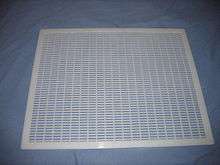Queen excluder

In beekeeping, the queen excluder is a selective barrier inside the beehive that allows worker bees but not the larger queens and drones to traverse the barrier. Queen excluders are also used with some queen breeding methods. Some beekeepers believe that excluders lead to less efficient hives.
Purpose
The intent of the queen excluder is to limit the queen's access to the honey supers. If the queen lays eggs in the honey supers and a brood develops it is difficult to harvest a clean honey product and it makes fall management more difficult. Queen excluders are removed in the autumn; otherwise, the queen would not be able to move with the winter cluster and would die from exposure. The death of the queen in winter will doom the hive as the beekeeper will not be able to have any new queen introduced in the spring accepted by the hive.
Queen excluders are used with some queen breeding methods, especially as a way to allow queen cells to be built in the same hive with an existing queen, or as a way to house multiple queens in the same hive.[1]
Design
Typically, the queen excluder is either a sheet of perforated metal or plastic or a wire grid in a frame with openings are limited to 0.163 inches (4.1 mm). Queen excluders can also be constructed of hardware cloth screen, of which #5 hardware cloth is often cited in references as sufficient for allowing worker bees to pass, but not queens.
References
- ↑ Doolittle, G.M. (1889). Scientific Queen-rearing as Practically Applied; Being a Method by which the Best of Queen-Bees are Reared in Perfect Accord with Nature's Ways. Chicago: Thomas G. Newman & Son.